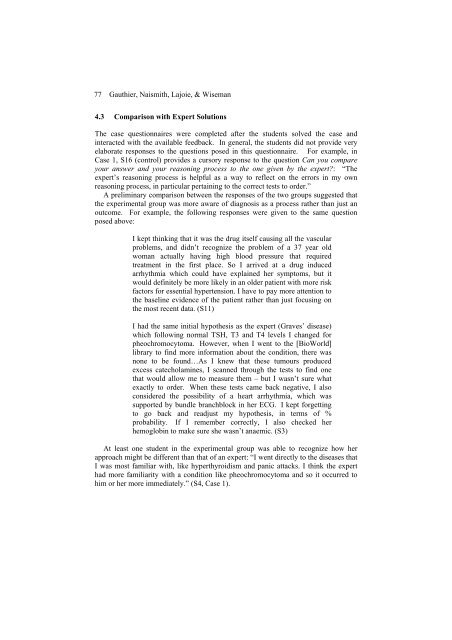Intelligent Tutoring Systems for Ill-Defined Domains - Philippe ...
Intelligent Tutoring Systems for Ill-Defined Domains - Philippe ...
Intelligent Tutoring Systems for Ill-Defined Domains - Philippe ...
Create successful ePaper yourself
Turn your PDF publications into a flip-book with our unique Google optimized e-Paper software.
77 Gauthier, Naismith, Lajoie, & Wiseman<br />
4.3 Comparison with Expert Solutions<br />
The case questionnaires were completed after the students solved the case and<br />
interacted with the available feedback. In general, the students did not provide very<br />
elaborate responses to the questions posed in this questionnaire. For example, in<br />
Case 1, S16 (control) provides a cursory response to the question Can you compare<br />
your answer and your reasoning process to the one given by the expert?: “The<br />
expert’s reasoning process is helpful as a way to reflect on the errors in my own<br />
reasoning process, in particular pertaining to the correct tests to order.”<br />
A preliminary comparison between the responses of the two groups suggested that<br />
the experimental group was more aware of diagnosis as a process rather than just an<br />
outcome. For example, the following responses were given to the same question<br />
posed above:<br />
I kept thinking that it was the drug itself causing all the vascular<br />
problems, and didn’t recognize the problem of a 37 year old<br />
woman actually having high blood pressure that required<br />
treatment in the first place. So I arrived at a drug induced<br />
arrhythmia which could have explained her symptoms, but it<br />
would definitely be more likely in an older patient with more risk<br />
factors <strong>for</strong> essential hypertension. I have to pay more attention to<br />
the baseline evidence of the patient rather than just focusing on<br />
the most recent data. (S11)<br />
I had the same initial hypothesis as the expert (Graves’ disease)<br />
which following normal TSH, T3 and T4 levels I changed <strong>for</strong><br />
pheochromocytoma. However, when I went to the [BioWorld]<br />
library to find more in<strong>for</strong>mation about the condition, there was<br />
none to be found…As I knew that these tumours produced<br />
excess catecholamines, I scanned through the tests to find one<br />
that would allow me to measure them – but I wasn’t sure what<br />
exactly to order. When these tests came back negative, I also<br />
considered the possibility of a heart arrhythmia, which was<br />
supported by bundle branchblock in her ECG. I kept <strong>for</strong>getting<br />
to go back and readjust my hypothesis, in terms of %<br />
probability. If I remember correctly, I also checked her<br />
hemoglobin to make sure she wasn’t anaemic. (S3)<br />
At least one student in the experimental group was able to recognize how her<br />
approach might be different than that of an expert: “I went directly to the diseases that<br />
I was most familiar with, like hyperthyroidism and panic attacks. I think the expert<br />
had more familiarity with a condition like pheochromocytoma and so it occurred to<br />
him or her more immediately.” (S4, Case 1).


